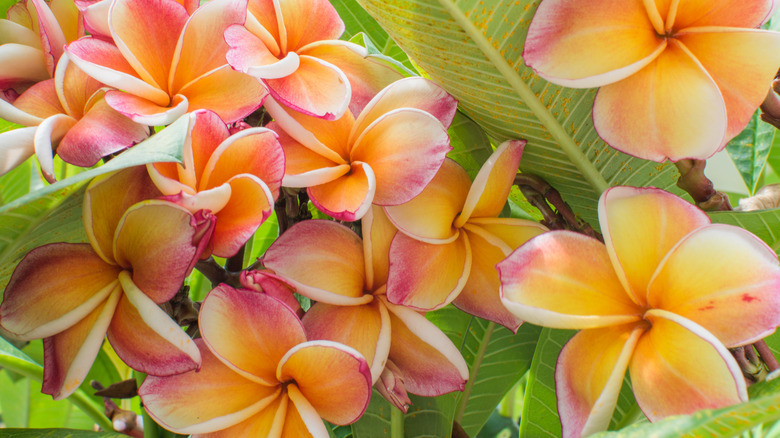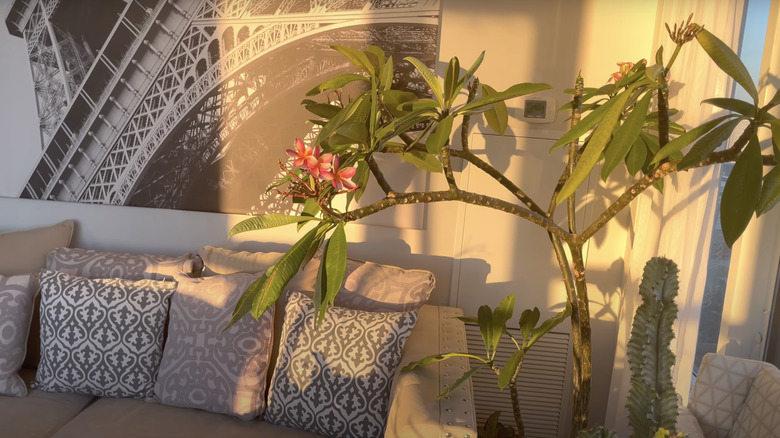The Fast-Growing Tree That Requires Little Maintenance And Boasts Tropical Flowers
If you're looking for a gorgeous, small tree to plant in your yard or a blooming plant to brighten up your home, the frangipani tree, or plumeria, is a great choice. Frangipani trees have many different varieties, but they all produce stunning yellow, white, red, or pink flowers that have an enticing scent. Though they're often associated with Hawaii, these plants are native to the Caribbean and more tropical spots in South and Central America. Because they are accustomed to warmer climates, frangipani trees do best outdoors in U.S. hardiness zones 10 to 12, but they can sometimes grow in zone 9. These trees can also make beautiful houseplants, though they may struggle to get enough light during the winter in colder places.
Despite this tree's harmless appearance, plumerias are somewhat toxic, according to the USDA Forest Service. Because of the alkaloids the plants contain, they can be poisonous to people and pets. The poisonous components are primarily in the sap that comes out when a flower is cut, which can cause gastrointestinal symptoms if ingested and skin irritation if touched; however, this sap is rather bitter and most people or animals that try it spit it out. Though it's unlikely to cause any serious harm, you might consider keeping children and pets away from your frangipani trees.
Growing frangipani trees outdoors
For those who want to grow frangipani trees in their yards, be sure that your climate is warm enough to sustain the plant throughout all four seasons. If that's the case, you'll likely want these low-maintenance trees in your landscaping. Frangipanis can survive in places where temperatures drop a bit below 50 degrees Fahrenheit, but they will lose a few leaves and stop blooming until it's warmer outside. In locations with much colder weather, you'll want to make sure your frangipani has a safe place inside for winter — and depending on the variety of plumeria you plant, your tree could grow 30 feet tall or more. Your tree should be given a spot that receives full sunlight and has well-draining soil for it to thrive.
Your frangipani will likely need to be given more water when the weather is hotter and on sunnier days; however, this plant prefers drier soil, and giving it more water than it needs could cause root rot. This is why it's important to wait for the soil to start drying out before watering. When the plant is actively growing during the spring and summer months, providing it with a phosphorus-rich fertilizer can help it produce flowers. During the other two seasons, your tree won't need fertilizer at all.
Frangipani trees as houseplants
Since these trees don't fare well against chilly temperatures, you may have better luck growing your frangipani in a pot. This way, you can move it outside during the warmest parts of the year and keep it indoors when the weather is too cold. Alternatively, you could keep your plumeria inside all year, but be careful to choose a variety that won't grow too tall. Make sure your tree is near a window where a lot of light streams in. During winter, you should not water your frangipani at all. Throughout other times of the year, you can water your tree when the soil dries out.
To successfully care for and grow your plumeria, you'll want to plant it in a larger pot filled with well-draining soil that's sandy or has some perlite or pumice added. Cactus potting mixtures can work well. As the tree grows, you may need to re-home it to a larger pot or trim the roots so that your frangipani will still fit in its original container. These measures should be taken near the end of winter before the primary growing season starts.


